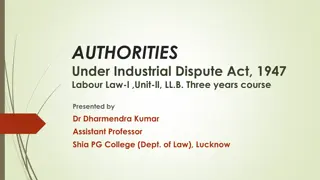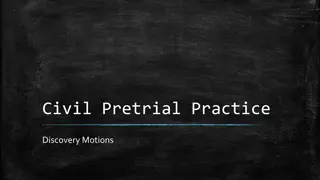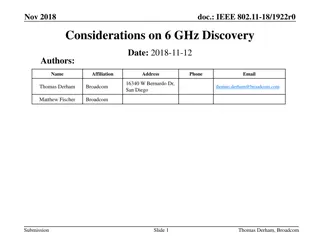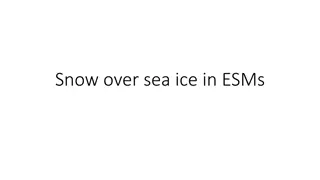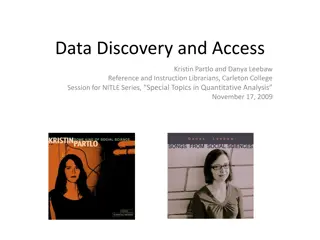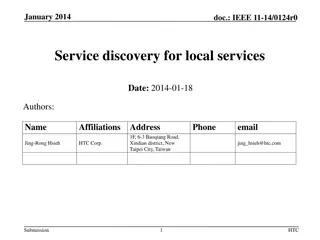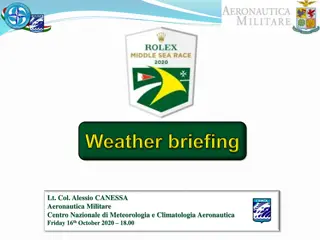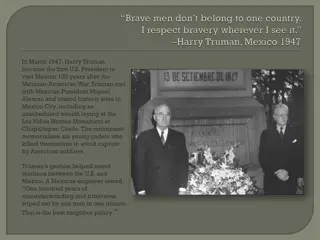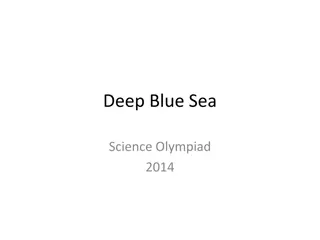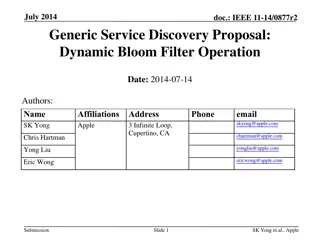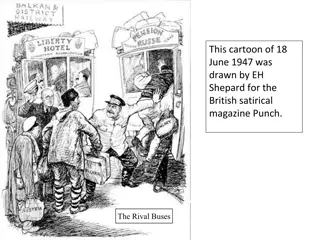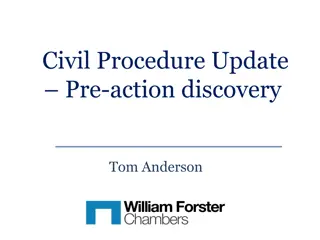The Fascinating Discovery of the Dead Sea Scrolls in 1947
In 1947, Bedouin shepherds made a remarkable discovery of ancient scrolls in caves near the Dead Sea in Palestine. Unaware of their significance, the scrolls were later identified as some of the oldest biblical manuscripts ever found, shedding light on Jewish history and the origins of Christianity.
Download Presentation

Please find below an Image/Link to download the presentation.
The content on the website is provided AS IS for your information and personal use only. It may not be sold, licensed, or shared on other websites without obtaining consent from the author.If you encounter any issues during the download, it is possible that the publisher has removed the file from their server.
You are allowed to download the files provided on this website for personal or commercial use, subject to the condition that they are used lawfully. All files are the property of their respective owners.
The content on the website is provided AS IS for your information and personal use only. It may not be sold, licensed, or shared on other websites without obtaining consent from the author.
E N D
Presentation Transcript
The Dead Sea Scrolls The Dead Sea Scrolls House Church House Church January 20, 2019 January 20, 2019 1
The Dead Sea Scrolls The Dead Sea Scrolls Introduction The Discovery of the Scrolls What Was Found? What Is a Scroll? Who Wrote the Scrolls? Dating the Scrolls: 200BCE-100CE Preserving the Scrolls Assembling Scroll Fragments Translating the Scrolls Why Are the Scrolls Significant? The Scrolls and Christianity 2
Discovering the Scrolls Discovering the Scrolls Historical Context: 1947, Palestine (west of Jordan River) is under British Administration (British Mandate, 1923), with Jerusalem as its Capital. Two nationalistic movements: Jews vs. Arabs, led to Civil War (1947- 1948) and resulted in partition, establishing (1) the state of Israel, (2) Arab West Bank annexed by Jordan, (3) the Gaza Strip under Egyptian protectorate. Jerusalem is split: East (Jordan), West (Israel). November, 1947. After a particularly rainy season, Bedouin goatherds and cousins Jum'a and Muhammed ed-Dib are grazing their sheep and goats by the caves at the northwest corner of the Dead Sea. Muhammed throws a rock into a cave, hears a crashing sound, and returns to his flock without entering the cave. Two days later, he returns, climbs up into the cave and makes what will become one of the most important archeological discoveries in history. Inside the cave, he finds four jars. The first three are empty. He opens the fourth and is repelled by a terrible odor, but when it dissipates, he reaches in and finds four scrolls. The cousins bring the scrolls to their tent near Bethlehem and, having no idea what they ve found, they unroll them and hang them on a tent pole, where the scrolls remain for several weeks. One scroll (The Community Rule) splits in half. The cousins and their friends bring the four scrolls to an antiquities dealer in Bethlehem, who considers them worthless forgeries. Finally they approach Khalil Eskander Shahin (Kando), who shows interest and tells the cousins to go back to the cave to see if there are more. They go back and find three additional scrolls. They return to Kando and sell him the first four scrolls for $4, then go to another antiquities dealer Sahili, who buys the other three. Kando (with the four scrolls) has a Syrian Christian friend in Jerusalem who thinks that his Bishop, Athanasius Yeshue Samuel might be interested. Kando sells his four scrolls to the Bishop for $64. Bishop Athanasius contacts John Trevor, President of the American Schools of Oriental Research (ASOR), and delivers the scrolls to him for evaluation. Trevor opens the first, recognizes it as the Book of Isaiah, sees that it is written in an ancient script and considers it unique, perhaps the oldest existing manuscript of a biblical book. He photographs the four scrolls and send the photos to Professor William F. Albright (world s preeminent archeologist, Johns Hopkins University) who, after reviewing the photos, describes their discovery as the Greatest archeological find of the 20thCentury. About the same time, Hebrew University Professor Eliezer Lipa Sukenik hears that Sahili has the three other scrolls and travels (sneaks) from Jerusalem to Bethlehem to see them. He immediately recognizes the scrolls as ancient Hebrew Scriptures and purchases them (see his reaction on the next slide). 3
Discovering the Scrolls Discovering the Scrolls My hands shook as I started to unwrap one of them. I read a few sentences. It was written in beautiful biblical Hebrew. The language was like that of the Psalms, but the text was unknown to me. I looked and looked, and I suddenly had the feeling that I was privileged by destiny to gaze upon a Hebrew Scroll which had not been read for more than 2,000 years. Hebrew University Professor Eliezer Hebrew University Professor Eliezer Lipa Lipa Sukenik Sukenik 4
Discovering the Scrolls Discovering the Scrolls Meanwhile Bishop Athanasius wants to sell his scrolls, thinks that he can get the best price for them in the United States, transfers them to the Syrian Church of New Jersey, and advertises them in the Wall Street Journal. He can t find a buyer, but when Sukenik hears that the four scrolls are for sale, he sends his young colleague archeologist Yigael Yadin to NY to purchase the scrolls. He meets Athanasius at the Walldorf Astoria, purchases the scrolls for $250,000 and brings them back to Israel. By 1955, all seven of the original scrolls are at the Hebrew University in Jerusalem. In the end, there will be only 11 mostly intact scrolls. In 1949, the Jordanian Department of Antiquities led by Gerald Lancaster Harding and Roland de Vaux undertake the first excavation of Cave 1. Two years later (1951), de Vaux, a team from ASOR (American Schools of Oriental Research) and Bedouins excavate the village of Qumran, a small town near to the caves. The settlement was then thought to be the home of the Essenes, who, due to their proximity to the caves, were immediately considered to be the authors of the scrolls. From 1951-1956, 10 other caves are discovered by de Vaux and his teams. From 1951-1957, all the scrolls and fragments are transferred to the Palestinian Archeological Museum (Rockefeller Museum) in East Jerusalem (Jordan). Here, between 1952-1967, the scrolls and scroll fragments are assembled, studied and translated, by a small international team of 8 scholars, led by de Vaux. These scholars kept the scrolls from the rest of the scholarly world. In 1967, after the Seven Days War, the entire collection comes under the control of the Israelis and is moved to West Jerusalem. Still the same 8-person team continues to exert tight control, until during the 1980 s, under intense international pressure, the scrolls are increasingly made available to the broader international academic community (more about this later). In February 2017, Hebrew University archaeologists announced the discovery of a new, 12th cave. There was one blank parchment found in a jar; however, broken and empty scroll jars and pickaxes suggest that the cave was looted in the 1950s. The blank parchment feeds theories about forgeries that regularly appear on the market (The Bible Museum in Washington, DC). 5
Discovery and Early Authentication of the Dead Sea Scrolls (1947 Discovery and Early Authentication of the Dead Sea Scrolls (1947- -48) 48) John Trevor first scholar to see the scrolls, John Trevor first scholar to see the scrolls, photographs and sends photos to Albright photographs and sends photos to Albright Shepherds Muhammed Shepherds Muhammed edh edh- -Dhib Dhib, his cousin , his cousin Jum'a Muhammed Jum'a Muhammed discover the scrolls discover the scrolls Bishop Athanasius Yeshue Bishop Athanasius Yeshue Samuel, Syrian Christian Samuel, Syrian Christian purchases 4 scrolls for purchases 4 scrolls for $64.00 $64.00 Israeli Hebrew Israeli Hebrew scholar Eliezer scholar Eliezer Lipa Sukenik buys 3 Sukenik buys 3 other scrolls from other scrolls from Bedouins and sends Bedouins and sends Yadin to NY to buy Yadin to NY to buy them them Yigael Yadin, archeologist, Yigael Yadin, archeologist, brings original scrolls to brings original scrolls to Jerusalem; they now reside Jerusalem; they now reside at Shrine of the Book in at Shrine of the Book in Israel Museum. Yadin later Israel Museum. Yadin later Deputy Prime Minister of Deputy Prime Minister of Israel. Israel. Lipa Bishop Samuel comes to U.S. to Bishop Samuel comes to U.S. to sell 4 sell 4 scrolls, sale is at the scrolls, sale is at the Walldorf for $250K to Yigael Walldorf for $250K to Yigael Yadin, who brings them to Israel Yadin, who brings them to Israel Hebrew scholar and Hebrew scholar and archeologist William F. archeologist William F. Albright authenticates Albright authenticates scrolls scrolls 6
Archeologist Roland De Vaux, Excavates Qumran, Archeologist Roland De Vaux, Excavates Qumran, Discovers other Caves (1951 Discovers other Caves (1951- -1056) 1056) Roland De Vaux, Roland De Vaux, leads research leads research into the scrolls into the scrolls until his death in until his death in 1971 1971 7
What Was Found in the 11 Caves? What Was Found in the 11 Caves? Fewer than a dozen mostly intact manuscripts, all found in Caves 1 and 11. 90,000+ fragments, many no larger than a fingernail, that belong to 980+ documents. Over 15,000 fragments were found in Cave 4 alone. More fragments continue to be discovered, some in cigar boxes in the dark corners of the museum (2013)!!! Coins, pottery, textiles and leather from the soles of shoes. Dead Sea Scrolls (DSS), including intact manuscripts and manuscripts reconstructed from fragments: Canonical Books (30% of the entire collection): 225 manuscripts of books from the Hebrew Bible (OT); several copies of every book except Esther (Psalms, 39 copies; Deuteronomy, 33; Genesis, 24; Isaiah, 22; Exodus, 18, etc.). These manuscripts are approximately 1000 years earlier than any previously existing manuscript of a book in the Hebrew Bible (the Aleppo Scroll had been the earliest, approximately 900 A.D.). Noncanonical books (20%): Jewish religious texts not considered a part of the Hebrew Bible, but included as Apocrypha in modern Catholic Bibles (e.g. Jubilees, Enoch, Tobit, Sirach). These are the earliest versions of these books, which previously had only existed in Greek and Latin. Nonbiblical Religious and Nonreligious Books (about 50%). Non-biblical books that provide commentaries on Biblical books, descriptions of the Messiah and what will happen when he returns, rules for synagogues or Jewish communities, and great insight into Jewish religious life from 200 BCE to 100CE (e.g., the Community Rule; the War Scroll, The Copper Scroll, The Temple Scroll). 8
Discovered at Qumran Discovered at Qumran 90,000+ 90,000+ fragments fragments The Great Isaiah Scroll The Great Isaiah Scroll The Copper Scroll The Copper Scroll 9
What Is a Scroll? What Is a Scroll? Consecutive columns of writing on pieces of vellum/parchment, sewn together to make the scrolls. Scrolls were written with black ink (carbon black mixed with olive oil, vinegar or honey), written with a reed pen on untanned animal skins (parchment or vellum); a few manuscripts are written on papyrus, and one on copper (a buried treasure map). Four types of animal skins were used (goat, calf, gazelle and ibex) Calf and goat were used for scrolls of greater significance Gazelle and ibex were used for scrolls of lesser significance Based on animal type, the thickness of the skin was an important clue for sorting fragments (discussed below) Written from right to left, with no punctuation, no vowels, no space between words. The letters simply run together in a continuous stream. This is true of many ancient Greek NT manuscripts (uncials and minuscules). Most of the scrolls were written in an old form of Hebrew; one of six were written in Aramaic; a few in Greek, and four in Cryptic Script (code), that was easily decoded. 10
Who Wrote the Scrolls? Who Wrote the Scrolls? Qumran and the Standard Model Qumran and the Standard Model The Essenes, an ascetic Jewish sect, who occupied Qumran from 200 BCE-70CE wrote the texts and stored them in the caves Supported by Josephus and original archeology by de Vaux Palestinian Jewish authors including Qumran Essenes Palestinian Jewish authors including Qumran Essenes Josephus and de Vaux s archeology questioned Based on handwriting, more than 850 authors (also important for sorting fragments), many more than could have lived a Qumran Many texts describe Jewish religious community life outside Qumran. Some are teaching manuals for leaders who are starting new synagogues Written by Jews, some books may have been kept in libraries of the Temple in Jerusalem, moved to the caves for safe-keeping when Jerusalem was invaded by Romans (70 CE) Provide a broad and diverse view of Jewish religious views during period from 200BCE-100CE 11
Dating the Scrolls (200 BCE Dating the Scrolls (200 BCE- -100 CE) 100 CE) Evidence from coins and pottery. Evidence from radio-carbon dating of the animal skins. Initial test in 1951 puts the date at 33 AD +/- 200 years; since then two sets of tests put the dates between 200 BCE-100CE. Paleographic dating, the analysis of the writing, including the forms of the letters, size of the letters and style of writing put the date of authorship in the same range. Internal evidence from the scrolls. Some scrolls describe attitudes and interactions with rulers and other leaders known to have lived during this period of time. 12
Preserving the Scrolls Preserving the Scrolls The scrolls began to deteriorate as soon as they were taken out of the clay jars in which they were stored, out of the caves and away from the arid and low humidity conditions present in the Qumran area adjoining the Dead Sea. At the beginning, lots of mistakes were made handling the fragments: Lighting in the scrollery in Jerusalem faded the fragments that had been arranged under the glass in the tables At first adhesive tape was used to join the fragments, destroying many Every time they moved the fragments, many disintegrated During the 1958 war with Egypt, the scrolls were stored in a damp vault where mildew destroyed many of them Glue from the envelopes in which fragments were stored got on the fragments and destroyed some. By 1990, approximately 20% of the scroll fragments had disappeared; they exist today only in photographs. In 1991, the Israeli Antiquities Authority established a temperature-controlled laboratory for the storage and preservation of the scrolls. Almost all of the DSS collection is currently owned by Israel, and housed in the Shrine of the Book on the grounds of the Israel Museum. The Israel Museum Digital Dead Sea Scrolls website gives users access to searchable, high-resolution images of the scrolls, as well as short explanatory videos and background information on the texts and their history. 13
Assembling the Scrolls Assembling the Scrolls Sorting 90,000+ fragments into 950+ documents Complicated by small size of fragments, illegibility or fading of writing, multiple copies of the same document Work is very slow and continues to this day Early work done in Jerusalem scrollery (see photo) Initial sorting done by handwriting analysis. Over 850 separate scribes, with distinct styles of writing Thickness of animal skin Photography of fragments made the text stand out (more readable) Pieces that seemed to fit together based on above criteria were grouped on long table and placed under glass. During the 1980s, opportunities to work on the DSS were expanded to a few locations around the world for respected scholars (and their graduate students), who were not among the original group of 8, but had participated in some way in the discovery of the scrolls. Beginning in 1993, the United States National Aeronautics and Space Administration (NASA) has used digital infrared imaging technology to produce photographs of DSS fragments. Recently NASA used multi-spectral imaging technique, adapted from its remote sensing and planetary probes, in order to reveal previously illegible text on fragments of the DSS. Scientists with the Israeli Antiquities Authority have used DNA from the parchment on which the DSS fragments were written, in concert with infrared digital photography, to assist in the reassembly of the scrolls. 14
The Scrollery The Scrollery In the Rockefeller Museum in the Palestinian Section of Jerusalem, In the Rockefeller Museum in the Palestinian Section of Jerusalem, scholars worked with 90,000+ Dead Sea Scrolls fragments, sorting scholars worked with 90,000+ Dead Sea Scrolls fragments, sorting them on tables in a room called the Scrollery. The process of sorting, them on tables in a room called the Scrollery. The process of sorting, arranging and translating these fragments has continued for 70 years, arranging and translating these fragments has continued for 70 years, to this day in locations around the world. to this day in locations around the world. 15
Translating the Scrolls Translating the Scrolls Fragments or manuscripts? If manuscript, proceed to last steps (transcription and translation) For Fragments: Match and group fragments (huge jigsaw puzzle): which cave, which language, handwriting, type of parchment, etc. Take photographs and assign number Working with photographs, try to reconstruct the original manuscript as much as possible Try to read words, identify gaps and fill in gaps Prepare a transcription similar to a typed version of a handwritten letter [brackets where gaps exist] Prepare a (not the ) translation (usually a team) Many words and phrases have no English equivalent Last step in an intricate and frequently uncertain process or reconstruction The best translators are cautious and humble 16
Why Are They Significant? Why Are They Significant? The DSS provide a new understanding about the nature of Judaism in the years leading up to and including Jesus life. Before the DSS, only one ancient historical record written about Judaism during this period: Josephus, The Antiquities of the Jews, a sweeping history from Creation to Josephus time. DSS scrolls provide a new and more comprehensive view of Judaism and the roots of Christianity. Impossible to adequately understand Jesus and the Gospel descriptions of him apart from this background. The DSS push back the date of existing Jewish manuscripts (biblical and nonbiblical) almost 1000 years, demonstrating that the transmission of these texts was incredibly accurate and reliable. Less than 2% deviation. In Non-Biblical religious texts, the DSS also demonstrate that authors took significant freedom to modify texts according to the purpose for which they would be used or for the recipients for whom they were intended. There are some additions and changes to OT Biblical texts, compared to later Hebrew versions, around which Jews and Christians will have to make decisions about the canon of scripture (e.g., should the extra Psalms, the end of Leviticus and other variations be included in the Bible?). There is an increasing search past theological jargon toward the beginnings of our faith and its original meaning. Who was Jesus, who was he originally understood to be, and what was his relationship to God? The DSS provide insight. 17
The Scrolls and Christianity The Scrolls and Christianity The Isaiah Scroll The Isaiah Scroll The Community Rule or Manual of Discipline The Community Rule or Manual of Discipline The Temple Scroll The Temple Scroll Melchizedek Fragments Melchizedek Fragments 18
The Scrolls and Christianity The Scrolls and Christianity Three Insights (a small sample): Melchizedek Fragments and the early ministry of Jesus The Community Rule and the ministry of Jesus The Temple Scroll, Jesus as the Prophet like Moses, and the mission to the Gentiles 19
The Dead Sea Scrolls The Dead Sea Scrolls and the New Testament and the New Testament House Church House Church March 3, 2019 March 3, 2019 20
Something Beautiful Something Beautiful Mark 14:3 Mark 14:3- -6 6 3While Jesus was in Bethany, reclining at the table in the home of Simon the Leper, a woman came with an alabaster jar of very expensive perfume, made of pure nard. She broke the jar and poured the perfume on his head. 4Some of those present were saying indignantly to one another, Why this waste of perfume? 5It could have been sold for more than a year s wages and the money given to the poor. And they rebuked her harshly. 6 Leave her alone, said Jesus. Why are you bothering her? She has done something beautiful to me. William Tyndale (1494 William Tyndale (1494- -1536) 1536) Published the first English Version of the Bible translated directly from the Greek and Hebrew texts and in the process invented many common English words and phrases (Passover, Jehovah, Forgive us our trespasses . . .) Invented the word beautiful for this passage (literal translation of two Greek words kalon ergon--meaning a good work ). 21
Review: DSS Review: DSS Discovery Contents and Authorship Contents and Authorship Discovery, Assembly, , Assembly, Between 1947-1956, 11 complete scrolls and 90,000+ fragments of scrolls from 960+ manuscripts were discovered in the caves on the northwest coast of the Dead Sea, near the ancient settlement of Qumran. By 1955, 7 of the first discovered scrolls were kept and studied at Hebrew University in Israel. The remaining scrolls and fragments were kept, assembled and studied at the Palestinian Archeological Museum (Rockefeller Museum) in East Jerusalem (Jordan). In 1967, all scrolls and fragments became the property of the State of Israel. Until the early 1980s, the assembly, translation and interpretation of the scrolls were conducted by a tightly controlled team of 8 scholars; then were increasingly released to the international academic community. The collection consists of Canonical OT Books (30%, 225 manuscripts); Noncanonical/Apocryphal books (20%), and nonbiblical religious and non- religious books (50%). All were written between 200BCE and 100 CE. Originally thought to be written by the Essenes of Qumran (an ascetic Jewish sect), today the scrolls are widely considered to describe Jewish religious thought and community life throughout Palestine in the years immediately preceding and during the ministry of Jesus. Some are teaching manuals for leaders who are starting new synagogues Some may have been kept in libraries of the Temple in Jerusalem, and moved to the caves for safe-keeping when Jerusalem was invaded by Romans (70 CE). 22
Review: DSS Significance Review: DSS Significance The DSS provide a new understanding of the nature of Judaism in the years leading up to and including Jesus life. Before the DSS, only one ancient historical record was written about Judaism during this period: Josephus, The Antiquities of the Jews, a sweeping history from Creation to Josephus time. Much of what we learned in Sunday School about ancient Judaism comes from Josephus. Now the DSS scrolls provide a new and more comprehensive view of Judaism and the historical and cultural background of Christianity. The DSS push back the date of existing Jewish manuscripts (biblical and nonbiblical) almost 1000 years, demonstrating that the transmission of these texts was incredibly accurate and reliable. Less than 2% deviation. There are some additions and changes to OT Biblical texts, compared to later Hebrew versions, around which Jews and Christians will have to make decisions about the canon of scripture (e.g., should the extra Psalms, the end of Leviticus and other variations be included in the Bible?). The DDS help us better understand the New Testament, what the early Christians were saying and writing about the identity of Jesus, about what it means to be a Christian, and about the character and mission of the Church (the new People of God ). This is the focus of today s class. 23
Todays Lesson: DSS and the New Testament Today s Lesson: DSS and the New Testament The DSS help us better understand numerous texts in the NT: e.g. the Melchizedek Fragments and the beginning of Jesus ministry in Luke. The DSS help us develop a more comprehensive understanding of the identify of Jesus as the Messiah, in the light of the three Jewish Messiahs of (1) David/Israel (God s representative to humanity), (2) Aaron (the mediator between God and humanity), and (3) the Prophet like Moses (giver of the new law), who must be obeyed. The NT portrayal of Jesus combines all three anticipated messianic figures. As the King and Son of God, Jesus represents the presence of God s love on earth, to know Jesus is to understand what God is like. As the High Priest, Jesus is the mediator between God and humanity, to believe in Jesus means that we can have a relationship with God. As the Prophet like Moses, Jesus is the giver of the new law, and the one whose words give life. To listen to Jesus gives us the direction and power to thrive (abundant life). The DSS help us develop a more profound understanding of what it means to be a Christian, the nature of the Gospel and what it means to be saved. The DSS help us better understand the NT s radical redefinition of the People of God, away from obedient Jewish law-keepers (i.e., the Righteous), to any unclean, sinful, flawed, or good person, regardless of race, gender or economic status, who believes in the vindicated Jesus and turns toward God (repentance in his name). The Triangle turned on its head. 24
Part One Part One The DDS Provide Insight into the Meaning of The DDS Provide Insight into the Meaning of Specific New Testament Texts Specific New Testament Texts 25
Insight: The Melchizedek Fragments (Cave 11) Insight: The Melchizedek Fragments (Cave 11) and the Beginning of Jesus Ministry in Luke and the Beginning of Jesus Ministry in Luke Luke 3-4: The Beginning of Jesus Ministry Jesus is baptized by John. The Spirit descends onto Jesus, a voice from heaven identifies him as God s Son one who has authority to speak for God (Psalm 2). Jesus meets Satan in the desert and Jesus rebuffs Satan s challenges. Satan has been given authority over the world ( oikumene Greek), but he has no power over Jesus. Satan departs from Jesus, who then begins his ministry in Galilee. Jesus goes into the synagogue in his hometown of Nazareth and reads from the scroll of Isaiah (61:1-2), The Spirit of the Lord is upon me to proclaim release to the captives. At first, the synagogue attendees are thrilled. Then after Jesus explains that this salvation of God is for lepers, widows, women and Syrians (i.e., the unclean, the poor, non-males, and non-Jews), they want to kill him. Son, a royal title, What Jewish expectation underlies the stories of the baptism, the temptation and the Nazareth sermon and incites the Synagogue attendees to try to kill Jesus? 26
The Melchizedek Fragments (Cave 11) The Melchizedek Fragments (Cave 11) Who was Melchizedek in the OT? Only mentioned in Genesis 14: a king of Salem, who worships a Canaanite God, Zedek, in pre-Israelite Jerusalem, who came out and blessed and fed Abraham Melchizedek in the DSS 11Q13 (Cave 11). Fourteen large fragments were found, written in Hebrew. Document dated to about 100 BC. The story has been reconstructed as follows: Melchizedek is a king in heaven (Son of God) who witnesses the battle in heaven where Satan (Belial) is defeated and cast down to earth and given authority over the house of men. Son of God = King (see Psalm 2) Melchizedek is sent to earth, anointed by God s Spirit, to defeat Belial. He brings judgment on Satan and his followers He announces God s victory over Satan to the sons of righteousness, reading Isaiah 61:1-2 and proclaiming the good news of God s salvation Salvation is offered to those who uphold the covenant, and turn away from walking in the way of the people Melchizedek Fragments Melchizedek Fragments Isaiah 61:1 Isaiah 61:1- -2 2 The spirit of the Lord GOD is upon me, the LORD has anointed me; he has sent me to bring good news to the oppressed, to bind up the brokenhearted, to proclaim liberty to the captives, and release to the prisoners; to proclaim the year of the LORD s favor 11QMelch provides evidence of an expectation in first-century Judaism that God would send a spirit-anointed, royal Son, who would deliver the righteous from Satan and would announce his mission to them, reading Isaiah 61:1-2, thus saving the righteous. 27
Parallels: Melchizedek and the Beginning Parallels: Melchizedek and the Beginning of Jesus Ministry of Jesus Ministry Melchizedek (11Q13) Melchizedek (11Q13) Jesus (Luke 3 Jesus (Luke 3- -4) 4) Son of God Son of God Anointed by the Spirit Anointed by the Spirit Sent to earth to oppose Satan Goes into the wilderness to confront Satan Satan is the ruler of the world (Hebrew: house of men ) Satan has power over the kingdoms of the world (Greek: oikumene: house of men ) Melchizedek defeats Satan and brings judgment on his followers Jesus defeats Satan s challenges Melchizedek is sent to the sons of righteousness Jesus begins his ministry in the Synagogue, the gathering place of the righteous Melchizedek proclaims salvation based on Isaiah 61:1-2 Jesus proclaims salvation based on Isaiah 61:1-2 Melchizedek announces that salvation has come to the sons of righteousness and that the unclean will be judged Jesus counters this expectation by saying that the salvation of God will come to those who could never have expected to receive it Sons of Righteousness rejoice Synagogue leaders want to kill Jesus 28
Part Two Part Two The Three Jewish Messiahs and The Three Jewish Messiahs and Jesus Identity as Messiah Jesus Identity as Messiah 29
The Identity of Messiah in the Old The Identity of Messiah in the Old Testament and Judaism before Jesus Testament and Judaism before Jesus The Old Testament understanding the identity of the expected Messiah focused primarily tracing his lineage back to David. Who was this expected Davidic Messiah? King David was anointed by the prophet Samuel. During biblical times, all subsequent kings of Israel were anointed and were required to be a part of the Davidic line (Psalm 2 is considered by many scholars to be Israel s enthronement Psalm, read at the inauguration of their kings). Between 140 and 114 BC, the Hasmoneans (also called the Maccabees) became the kings of Israel. They had been priests from the Levite line, which had never been considered to be a part of the Davidic line of Kings, thus violating the cardinal rule. This fact was considered by Orthodox Jews to have led to the downfall of the Hasmoneans at the hands of the Romans, who after 114BC controlled Judea. During the period after 114BC the term Messiah came to refer to a future Jewish King of the Davidic line who would usher in the messianic age, when the Romans would be expelled and Israel would be restored to its former greatness, as it was in the days of King David. 30
The Identity of Messiah in the Old The Identity of Messiah in the Old Testament and Judaism before Jesus: DSS Testament and Judaism before Jesus: DSS The Dead Sea manuscripts demonstrate that during the years leading up to the ministry of Jesus, there was among Jews throughout Palestine, an expectation that in the near future, at least three separate messiahs, modeled on the traditional roles of prophet, priest and king, would together usher in the messianic age: The Messiah of Israel (the Davidic King, who would represent God to humanity) The Messiah of Aaron (a messianic high priest from the line of Aaron, who would mediate between God and people) The Prophet like Moses (a new lawgiver): the predominant figure, who was considered to be pre-existent with God before the beginning of Creation and who would give the new law and hold people accountable for obeying it. This understanding was based on Hebrew Scripture, where term Messiah comes from verb meaning to smear with oil. Three offices were ceremonially blessed (authorized and ordained) by God, symbolized by the smearing of oil on the head (anointing) of the one taking the office: the King/ Son of God (Psalm 2), the High Priest (Psalm 110), and the Prophet like Moses (Deut. 18:15-18). 31
DSS Texts: The Messiahs of the DSS: DSS Texts: The Messiahs of the DSS: The Messiahs of Aaron and Israel The Messiahs of Aaron and Israel Testament of the Twelve Patriarchs (130 Testament of the Twelve Patriarchs (130- -110 BCE): My children, be obedient to Levi and to Judah. Do not exalt yourselves about these two tribes because from them will arise the Savior from God. For the Lord will raise up from Levi someone as a high-priest and from Judah someone as king. He will save all the gentiles and the tribe of Israel.[Testament of Simeon 7.1- 2.] To me [Judah], God has given the kingship, and to him [Levi], the priesthood. And He has subjected the kingship to the priesthood. To me He gave earthly matters and to Levi heavenly matters. As heaven is superior to the earth, so is God's priesthood superior to the kingdom on earth. [Testament of Judah 21.2-4a.] 110 BCE): Damascus document Damascus document (60 [...] during the time of ungodliness until the appearance of the Messiahs of Aaron and Israel [...][Damascus document 12.23-13.1.] This is the exact statement of the ordinances in which they walk until the Messiah of Aaron and Israel appears and expiates their iniquity.[Damascus document 14.18-19.] Those who heed Him are the poor of the flock; they will be saved at the time of visitation. But others will be delivered up to the sword at the coming of the Messiah of Aaron and Israel.[Damascus document 19.9-11; similar ideas can be found in 19.33-20.1.] (60- -30 BCE) 30 BCE) 32
The Messiahs of the Dead Sea Scrolls: The Messiahs of the Dead Sea Scrolls: Messianic Hierarchy: Aaron then Israel Messianic Hierarchy: Aaron then Israel 1QSa 1QSa also describes the table arrangement during the messianic meal. The interesting point is the hierarchy between the Messiahs of Aaron and Israel. This is the procedure for the men of renown called to the assembly for the council of the community when God will have begotten the Messiah among them. The Priest Messiah shall enter at the head of all the congregation of Israel, then are all the chiefs of the sons of Aaron, the priests, called to the assembly, men of renown. And they shall sit before him, each according to his rank. Afterwards, the Messiah of Israel shall enter. The chiefs of the tribes of Israel shall sit before him, each according to his rank, according to their position in the camps and during their marches; then all the heads of family of the congregation, together with the wise men of the congregation, shall sit before them, each according to his rank. And when they gather for the community table, or to drink wine, and arrange the community table and mix the wine to drink, let no man stretch out his hand over the first-fruits of bread and wine before the Priest. For it is he who shall bless the first Priest. For it is he who shall bless the first- - fruits of bread and wine, and shall first stretch out his hand over the brea fruits of bread and wine, and shall first stretch out his hand over the bread. And afterwards, the Messiah of Israel shall stretch out his hands over the bread. And afterwards, all the congregation of the community shall bless, each according to his rank. [1QSa 2.11-21] 33
The Messiahs of the DSS: The Messiahs of the DSS: The Prophet like Moses The Prophet like Moses Deuteronomy 18:15-21: The LORD your God will raise up for you a prophet like me from among you, from your brothers it is to him you shall listen. And I will put my words in his mouth, and he shall speak to them all that I command him. 19And whoever will not listen to my words that he shall speak in my name, I myself will require it of him. Numerous DSS scrolls highlight the importance of this expectation during the century that precedes the ministry of Jesus: The Moses Apocryphon (4Q377). The Moses Apocryphon (4Q377). Provides an understanding of how Moses was perceived in the first century before Jesus. Testifies to the overwhelming importance of Moses authority as the legitimator of religious ideas, he is described as the anointed one (Messiah), the herald of glad tidings, who teaches from the mountain, who speaks with God face to face as one might speak to a friend. 4Q175: Messianic Proof Texts. 4Q175: Messianic Proof Texts. In this set of proof texts, the Prophet like Moses is listed first (see Deuteronomy 18:15-21, top of this slide) The Temple Scroll. The Temple Scroll. This is the longest of all DDS (28 ). The book is considered to be the revelation of the promised New Moses (Deut. 18). It details the architecture of the new Temple that is to be built, the importance of purity in the messianic age, the introduction of new festivals, sacrifices and regulations, and omits from the Biblical Book of Deuteronomy all reference to foreigners and sojourners (i.e. in the messianic age, there will be no Gentiles within the boundaries of the land). 34
The Three Messiahs: Israel, Aaron and The Three Messiahs: Israel, Aaron and The Prophet like Moses The Prophet like Moses 1QSa, Charter of a Jewish Sectarian Society (Manual of 1QSa, Charter of a Jewish Sectarian Society (Manual of Discipline, Community Rule) (130 Discipline, Community Rule) (130- -110 BCE) messiahs: : And they shall not depart from any counsel of the law to walk in all the stubbornness of their heart, but they shall be governed by the first ordinances in which the members of the community began their instruction, until the coming of the prophet and the anointed ones of Aaron and Israel (1QSa 9.9b-11) 110 BCE) mentions all three 4Q175: Messianic Proof Texts: 4Q175: Messianic Proof Texts: A set of Hebrew Bible (OT) texts that justify the messianic expectations of the prophet like Moses (Deut. 5:28-29, 18:1-19); Royal Messiah of Israel (Numbers 24:15-17); Aaronic Messiah (Priest) (Deut. 33:8-11) 35
The Three Messiahs of the DSS: Summary The Three Messiahs of the DSS: Summary During the time of Jesus there was among Jews a diversity of expectations about the identity of the coming messiahs The DSS expectation included at least three figures, working together: the messiahs of Aaron, Israel, and the Prophet like Moses These reflected the importance of three distinct offices or roles within the Jewish administration of divine authority on earth: Messiah of Israel (David): King: the Son of God, who represents God and rules the earth Messiah of Aaron: (Aaron) Priest, who mediates between God and people, making God accessible to humanity Prophet like Moses: Legal/Prophet, who gives the new law and holds people accountable (obedience), deciding who is in and out. 36
Jesus Christ: How Did the Early Christians Jesus Christ: How Did the Early Christians Understand His Identity as the Messiah? Understand His Identity as the Messiah? After the resurrection, the first Christians called Jesus Christ. The Greek word Christ (Christos) is the Hebrew word for Messiah. Prior to the DDS, our understanding of the identity of Jesus as the Messiah focused on his Davidic descent, that is, he is the King from David s line who would restore God s kingdom on earth: He announces the coming of God s Kingdom: The Kingdom of God has come. The birth stories link Jesus to David Jesus followers are disappointed when he comes into Jerusalem and does not overthrow the Romans, and from The sign on the cross: This is the King of the Jews. To what extent is Jesus identity as Christ/Messiah informed by the expectation set out in the DSS that the Messiah would be a King, a Priest and a Prophet? Do these three roles joined in the person of Jesus more comprehensively define what it means to be saved and how Jesus empowers the character of the Christian living ( abundant life ) in relationship to God? 37
Jesus Identity as Messiah King (Son of God, Jesus Identity as Messiah King (Son of God, Lord) Lord) The Gospels describe Davidic Kingship: he is the King from David s line who would restore God s kingdom on earth: He announces the coming of God s Kingdom: The Kingdom of God has come. The birth stories and genealogies link Jesus to David (Matthew 1:1; 2:6; Luke 2:11; 3:31) Jesus followers are disappointed when he comes into Jerusalem and does not overthrow the Romans (Palm Sunday) Jesus is crucified as the King of the Jews (John 11:36-37). The sign on the cross: This is the King of the Jews. Primary link to Davidic Kingship in Jesus Ministry is through title Son of God, a royal title and Jesus proclamation of the coming of the Kingdom of God : Psalm 2, enthronement Psalm; many were called Son of God in OT. Jesus ministry as the unique Son of God (John 3:16). Monogenes = one of a kind Son. Hebrews 11:17-19, used to describe Isaac, Abraham s preferred son or unique son, but not his only son. Means that Jesus was God s unique representative, speaking God s words on earth (see also Baptism and Tranfiguration. Jesus resurrection as Lord = King (Acts 2:36, This Jesus whom you crucified, God has made both Christ/Messiah and Lord/King ). Jesus as the heavenly king in the Book of Revelation 19:16, King of Kings and Lord of Lords 38
Jesus Identity as High Priest/Aaronic Jesus Identity as High Priest/Aaronic Messiah Messiah The New Testament includes frequent references to Jesus death as a sacrifice that is central to our salvation. For example: John s Gospel refers to Jesus as the lamb of God who takes away the world s sin (1:29), and Revelation takes up the same image. Hebrews describes Jesus as the Hight Priest of Aaron who calls us to repentance through the sacrifice of his own self (9:26). Paul attests that God sets forth Jesus as a sacrifice (literally, place of atonement ) by his blood (Romans 3:25). Important to understand what this means. Our understanding has been influenced by a doctrine that is limited in its understanding of sacrifice : Substitutionary Atonement. Jesus death amounts to a substitution: God being just must punish human sin. Jesus takes our place, enduring our punishment through his agonizing death. His suffering removes God s judgment. God requires that Jesus must die in order for us to escape God s righteous wrath. Jewish sacrifices did not represent human attempts to purchase forgiveness by sacrificing animals; rather through the ritual of sacrifice, God reached out to humans and invited their response; the sacrifice gave the Jews the opportunity to acknowledge their separateness from God and the costliness of their sin and to turn away from it through repentance. 39
Jesus Identity as High Priest/Aaronic Messiah: Jesus Identity as High Priest/Aaronic Messiah: Jesus Death and the Jewish Meaning of Sacrifice Jesus Death and the Jewish Meaning of Sacrifice The key to understanding sacrifice comes with understanding the significance of blood as a symbol of the life force. In the sacrifice, God is saying, As you witness the bleeding, life is going out of this animal, so also, apart from me, the life is going out of you. Turn to me that you might have life. According to many OT texts, God freely offers forgiveness. God is ready to forgive people at anytime without sacrifice or without hurting anyone. God s justice, or righteousness, involves God s saving action on behalf of humankind. True justice does not require the shedding of blood. True justice heals (see the Sermon on the Mount). The Jewish Scriptures and the nature of God s forgiveness: God is compassionate and gracious, slow to anger, abounding in kindness and faithfulness (Exodus 34:6) When all manner of sins overwhelm me, it is You who forgive my iniquities (Psalm 65:3) True sacrifice to God is a contrite spirit (Psalm 51:17) To describe the sacrifice of Jesus is not to describe a penalty substitution, but to say only that like the sacrificed Lamb, Jesus death reminds us of he impact on our lives of separation from God and calls us into relationship with him. This is Jesus role as Priest or Mediator. 40
Jesus Identity as the Prophet Jesus Identity as the Prophet- -Like Moses Like Moses Jesus is specifically identified as the Prophet-Like-Moses by Luke following the resurrection,. He is the one who must be listened to for one to become a part of the new People of God (Acts 3:22-23). Stephen s speech (Acts 7:20-53): extensive comparison between Moses and Jesus: both were rejected by their people. Clear Moses and Jesus parallels in Matthew: Jesus and Moses birth parallels Both fast 40 days and nights in the desert before ascending a mountain to give the law (10 Commandments; 10 Beatitudes) Five books of the Torah; five parts to Matthew s Gospel Transfiguration: Moses appears on a mountain in the presence of Jesus, Jesus is transfigured. His face shone like the sun and His clothes became white as light. Then, God spoke out of a cloud, This is my beloved Son, with whom I am well pleased; listen to him (Matthew 17:2-5). Jesus is like Moses, but greater than Moses (Hebrews 3:1-6) ([Moses] vs [Jesus] rebuilds God s house; is this a reference to the Temple Scroll???). Today, the focus of a significant amount of scholarly research into all the Gospels concerns how Jesus is portrayed as the Prophet like Moses while not always explicitly called by that name. None of this research predates the discovery of the Dead Sea Scrolls. 41
Part Three Part Three Prophet, Priest and King Prophet, Priest and King The Threefold Understanding of Jesus Identity as Messiah and the Meaning of Salvation 42
Jesus Identity as Insurance Agent Jesus Identity as Insurance Agent Two post-death options: heaven or hell. No possibility of heaven because we are sinners and have no chance with a perfect God. Jesus death pays the price for our sin, he died in our place, he was sacrificed, so that God no longer sees us as sinners (substitutionary atonement). Jesus provides the insurance policy. Accept it and when you die you go to heaven; don t accept and you go to hell. Faith gives us assurance of eternal life after death. Faith gives us assurance of eternal life after death. If understood correctly, this is an adequate place to start, but a very partial and limited understanding of the salvation God offers us. What is offered to us as Christians is much more. 43
Jesus is Christ/Messiah in the Minds of Jesus is Christ/Messiah in the Minds of the First Christians the First Christians Jesus, the Son of God (baptism), comes, representing God, to proclaim that God is not separate from humanity, but loves the world and all who are in it. The Kingdom of God has come. While our sin may separate us from God, and impact the quality of our lives and relationships with others, it does not separate God from us (For God so loved the world he sent his Son . . . ) The loving presence of God in the world was demonstrated before the crucifixion, throughout the ministry of Jesus, who offered the love of God to all who could never have expected to receive it (based on the prevailing understanding of the law and the requirement to obey it perfectly, as in the DSS). This included sinners, Gentiles, women, children, maimed, blind, lepers, elderly, poor. This message, this view of God, so threatened the ruling religious establishment that they killed Jesus, effectively killing off this view of God. Jesus was crucified as the ridiculed King (Messiah) of the Jews (the sign on the Cross). The resurrection is God s vindication of the crucified Jesus The resurrection is God s vindication of the crucified Jesus. It confirms his authority to speak for God ( belief in his name ). Turning toward the God who loves us is what frees us from sin ( This Jesus whom you crucified, God has made both Christ and Lord. ) Jesus as King, Son of God, sits now at God s right hand, and the Spirit of the God, in the world and our hearts, sustains the presence of God s love in our lives. The measure of the presence of God in our life is not purity or perfect obedience (Romans 8:1- 2), we cannot help but sin (Romans 7), but is the Great Commandment and summary of the Law: love God, self and neighbor. We love because God first loved us (1 John 4:9). If God loves us, the abundant life we can experience now will only be immeasurably better when we die and see God face-to-face. As Jesus was raised, so will our own eternal life be the final vindication of our faith in God s love. 44
The Identity of Jesus the Messiah The Identity of Jesus the Messiah I am the I am the way way, the , the truth truth, and the , and the life life. John 14:6 . John 14:6 Jesus the Priest Jesus the Priest shows and makes possible shows and makes possible the Way mediator with God. He is the sacrifice that calls us to repentance (High Priest/Aaron; Lamb of God), through him our relationship to God is established and sustained, through him we are invited into God s love. Jesus makes the connection (mediator). Way to God. Jesus is our Jesus the Prophet Jesus the Prophet tells the Master; Word) Master; Word). Jesus Resurrection is a vindication of what Jesus said about God, calling us to abandon our legalism in favor of a life of love and service as we experience the presence of God s love. Believe the prophet and become a part of the People of God. tells the Truth Truth about God (Prophet about God (Prophet- -Like Like- -Moses; Rabbi; Moses; Rabbi; Jesus the King Jesus the King provides abundant provides abundant Life Because Jesus is God s Son, we can we certain that God is like him and that he speaks for God. Direct access to God provides empowerment for Christian living, and thereby, the allows us to thrive (abundant life) and love, as God loves (John 3:16, God sent Jesus the Son so that we might have life). Life (Lord, King, Son of God s Spirit). (Lord, King, Son of God s Spirit). 45
Part Four Part Four Who Are the People of God? Who Are the People of God? 46
Who Gets Included in the Benefits of the Who Gets Included in the Benefits of the Messiah in the DSS? Messiah in the DSS? Only the Righteous (those who meticulously followed the law) Only the Righteous (those who meticulously followed the law) Completely Excluded (the Unclean) Sinners Gentiles Those with the blemish: Lepers The lame or maimed The blind Women Children The feeble-minded Those temporarily excluded or included with reduced rations (the Lawbreakers) Those who mistakenly show their nakedness Those who spit to the left Those who have been near a woman during her unclean time of the month Many, many more examples 47
The Messiah: DDS and Jesus The Messiah: DDS and Jesus Who is invited to eat with the Messiah? Who is invited to eat with the Messiah? 1QSa 2:4 1QSa 2:4- -8 8 Luke 14:12 Luke 14:12- -15:2 Now the tax collectors and sinners were all drawing near to hear him. And the Pharisees and the scribes murmured, saying, This man receives sinners and eats with them. Jesus said: When you give a banquet, invite the poor, the crippled, the lame, and the blind and you will be blessed. 15:2 No man smitten in his flesh, or paralyzed in his feet or hands, or lame, or blind, or deaf, or dumb, or smitten in his flesh with a visible blemish; no old and tottery man unable to stay still in the midst of the congregation; no madman, or lunatic shall enter, no simpleton, or fool, no blind man, or maimed, or lame, or deaf man, and no minor (child), no woman, none of these shall enter the community 48
Jesus the Messiah: Who Is Included? Jesus the Messiah: Who Is Included? Included: Included: Sinners (Mt 9:10-17; Mark 2:15-22; Luke 5:29-39) Gentiles (Matthew 15:21-28; John 4; The Book of Acts)) Those with the blemish: Lepers (Matthew 8; Luke 17) The lame or maimed (John 5) The blind (John 9) Women (John 4, Matthew 15, Lk 10:38-42, Mk 14:3-6) Children (Matthew 19:14) Even those who killed Jesus (Acts 3:17-23) No one is excluded ( God so loved the world, John 3:16) 49
Jesus the Messiah: What Is Required? Jesus the Messiah: What Is Required? What is required? Rigorous obedience to the Law? Absolute purity? What is required? Rigorous obedience to the Law? Absolute purity? Believing in the name of Jesus and turning toward God s love (repentance) Faith and love, not rigorous law-keeping (simplicity) Prayer, not Sacrifice (immediacy, direct and constant access to God, not through the priest) Baptism, not circumcision (opens inclusion to women, non-Jews) Communion fellowship with all, not obsessive observance of food laws that exclude (characterized by joy and fellowship, not seriousness and score-keeping) Obedience empowered by God s love, not obedience as a qualification for God s love (empowerment, learning and freedom) 50



